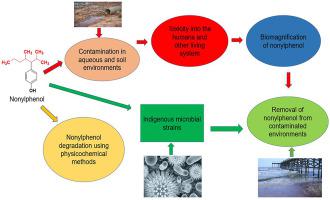Chemosphere ( IF 8.1 ) Pub Date : 2021-02-20 , DOI: 10.1016/j.chemosphere.2021.130013 Geeta Bhandari , Ahmad Reza Bagheri , Pankaj Bhatt , Muhammad Bilal

|
Nonylphenol (NP) is considered a potential endocrine-disrupting chemical affecting humans and the environment. Due to widespread occurrence in the aquatic environment and neuro-, immuno, reproductive, and estrogenic effects, nonylphenol calls for considerable attention from the scientific community, researchers, government officials, and the public. It can persist in the environment, especially soil, for a long duration because of its high hydrophobic nature. Nonylphenol is incorporated into the water matrices via agricultural run-off, wastewater effluents, agricultural sources, and groundwater leakage from the soil. In this regard, assessment of the source, fate, toxic effect, and removal of nonylphenol seems a high-priority concern. Remediation of nonylphenol is possible through physicochemical and microbial methods. Microbial methods are widely used due to ecofriendly in nature. The microbial strains of the genera, Sphingomonas, Sphingobium, Pseudomonas, Pseudoxanthomonas, Thauera, Novosphingonium, Bacillus, Stenotrophomonas, Clostridium, Arthrobacter, Acidovorax, Maricurvus, Rhizobium, Corynebacterium, Rhodococcus, Burkholderia, Acinetobacter, Aspergillus, Pleurotus, Trametes, Clavariopsis, Candida, Phanerochaete, Bjerkandera, Mucor, Fusarium and Metarhizium have been reported for their potential role in the degradation of NP via its metabolic pathway. This study outlines the recent information on the occurrence, origin, and potential ecological and human-related risks of nonylphenol. The current development in the removal of nonylphenol from the environment using different methods is discussed. Despite the significant importance of nonylphenol and its effects on the environment, the number of studies in this area is limited. This review gives an in-depth understanding of NP occurrence, fate, toxicity, and remediation from the environments.
中文翻译:

发生,潜在的生态风险以及水性环境中内分泌干扰物壬基酚的降解
壬基酚(NP)被认为是一种潜在的破坏内分泌的化学物质,会影响人类和环境。由于在水生环境中广泛存在,并且具有神经,免疫,生殖和雌激素作用,因此壬基酚引起了科学界,研究人员,政府官员和公众的极大关注。由于其高疏水性,它可以在环境中,特别是在土壤中长期存在。壬基酚通过农业径流,废水,农业资源和地下水从土壤中渗漏而被掺入水基质中。在这方面,评估壬基酚的来源,命运,毒性作用和去除似乎是一个高度优先的问题。通过物理化学和微生物方法可以修复壬基酚。由于自然界中的生态友好性,微生物方法被广泛使用。属的微生物菌株鞘氨醇单胞菌,鞘氨醇单胞菌,假单胞菌,假黄单胞菌,丘拉属,新孢子虫,芽孢杆菌,嗜单胞菌,梭状芽胞杆菌,关节杆菌,酸杆菌属,马里科弗斯,根瘤菌,棒状杆菌,球形杆菌,伯克霍尔德氏菌,不动杆菌,曲霉属镰刀菌和绿僵菌已经报道了它们通过其代谢途径在NP降解中的潜在作用。这项研究概述了有关壬基酚的发生,来源以及潜在的生态和人类相关风险的最新信息。讨论了使用不同方法从环境中去除壬基酚的最新进展。尽管壬基酚及其对环境的影响非常重要,但该领域的研究数量有限。这篇综述深入了解了NP的发生,命运,毒性以及从环境中的修复。









































 京公网安备 11010802027423号
京公网安备 11010802027423号